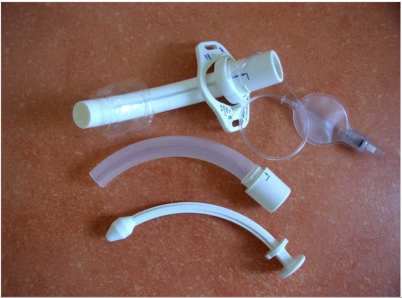Tracheostomy Basics
Anatomy of the Tracheostomy
1. Outer cannula = tracheostomy tube itself, may or may not have a cuff
- A hint is that a cuffed tube will have a pilot balloon as pictured below, similar to an endotracheal tube
- Benefit of a cuffed tube is that the balloon can be inflated and the trach may then be used for mechanical ventilation
2. Inner cannula
- Removable insert used for cleaning of respiratory secretions
- Often not present in pediatrics as small diameter to begin with
3. Obturator
- Used for insertion of tracheostomy to prevent local trauma from sharper edges of tracheostomy tube itself

Pertinent questions:
1. When was the tracheostomy placed?
2. Why it was placed?
3. Who placed it?
4. What type - Size? Cuffed or uncuffed? Manufacturer?
--------------------------------------------------------------------------------------------------------------------------------------------
How to Change a Trach in a Stable Patient
***Note: consult surgeon to change if <7 days old as tract will not be fully matured and there is risk of creating a false passage or collapsing the tract itself***
Equipment:
- Spare tracheostomy tube in patient’s size and a size below
- Suction - both a Yankauer and a smaller suction device that can fit through the stoma
- Tracheostomy ties
- Good lighting
Steps:
- Remove trach (ensure balloon is deflated if cuffed)
- Suction area
- Replace with new trach with obturator inserted
- Remove obturator
- Inflate balloon if cuffed
- Insert inner cannula
- Secure with trach ties (typically come in box with trach tube)
- Verify by passing a suction catheter through trach

--------------------------------------------------------------------------------------------------------------------------------------------
References:
1. Bryant, C. “Complications of Airway Devices.” Tintinalli’s Emergency Medicine: A Comprehensive Study Guide, 8th Ed. Judith E. Tintinalli, et al. New York, NY: McGraw-Hill, 2016.
2. Cumpstey Andrew, Benzie Stuart J, McKechnie Stuart. Tracheostomy management BMJ 2012; 345 :e6016
